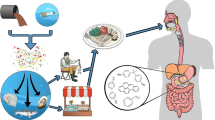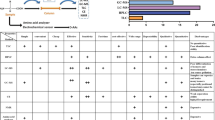Abstract
Tuna is one of the most popular fish and therefore among the most commercially valuable seafood. However, inadequate refrigeration during the whole supply chain causes serious economic loss and food poisoning. One important result of tuna spoilage is the accumulation of biogenic amines such as histamine, which can be used as a sensitive indicator for Tuna freshness. Thus, the development of rapid, sensitive, and economic analytical methods for biogenic amines in Tuna is highly desired. This research developed a method that combines high-performance liquid chromatography (HPLC) and electrospray ionization ion mobility spectrometry (ESI-IMS) to detect 7 kinds of biogenic amines including tryptamine, tyramine, spermidine, cadaverine, β-phenylethylamine, putrescine, and histamine in tuna. The limit of detections (LODs) for 7 biogenic amines are 0.01, 0.02, 0.02, 0.17, 0.03, 0.04, and 0.15 mg L−1 respectively. The linear range of histamine and spermidine is 2–100 mg kg−1, and the linear range of other biogenic amines is 0.5–10 mg L−1. The recoveries of biogenic amines are between 69.39 and 112.65%. Compared to the traditional HPLC-based analytical method, the proposed method does not involve any derivatization steps, which greatly decreased the sample preparation time and cost. Another advantage of the developed method is the supplementary separation to the HPLC, in which coeluted biogenic amines can clearly be separated in the ion mobility dimension. The proposed method is applied to determining the concentration of biogenic amines in tuna storage, which showed that this method can quickly and accurately monitor the changes of biogenic amines in tuna during storage.




Similar content being viewed by others
Data Availability
The datasets generated during and/or analyzed during the current study are available from the corresponding author on reasonable request.
References
Agnieszka U, Magdalena L, Anton A, Buszewski B (2008) Determination of volatile organic compounds in exhaled breath by ion mobility spectrometry. Chem Anal (warsaw) 53:953–965
Al Bulushi I, Poole S, Deeth HC, Dykes GA (2009) Biogenic amines in fish: roles in intoxication, spoilage, and nitrosamine formation-a review. Crit Rev Food Sci Nutr 49:369–377. https://doi.org/10.1080/10408390802067514
Almeida C, Fernandes JO, Cunha SC (2012) A novel dispersive liquid–liquid microextraction (DLLME) gas chromatography-mass spectrometry (GC–MS) method for the determination of eighteen biogenic amines in beer. Food Control 25:380–388. https://doi.org/10.1016/j.foodcont.2011.10.052
Alves SP, Alfaia CM, Škrbić BD, Živančev JR, Fernandes MJ, Bessa RJB, Fraqueza MJ (2017) Screening chemical hazards of dry fermented sausages from distinct origins: biogenic amines, polycyclic aromatic hydrocarbons and heavy elements. J Food Compos Anal 59:124–131. https://doi.org/10.1016/j.jfca.2017.02.020
Angulo MF, Flores M, Aranda M, Henriquez-Aedo K (2020) Fast and selective method for biogenic amines determination in wines and beers by ultra high-performance liquid chromatography. Food Chem 309:125689. https://doi.org/10.1016/j.foodchem.2019.125689
Anna H, Ágnes B, Livia S-S, Wilhelm H (1994) Biogenic amines and their production by microorganisms in food. Trends Food Sci Technol 5:42–49. https://doi.org/10.1016/0924-2244(94)90070-1
Bai J, Baker GL, Baker SM, Goodrich Schneider RM, Montazeri N, Sarnoski PJ (2019) Simultaneous determination of amino acids and biogenic amines in tuna and Mahi-Mahi by reversed-phase ultra-high performance liquid chromatography. J Aquat Food Prod Technol 28:848–860. https://doi.org/10.1080/10498850.2019.1652715
Bao-Shyung H, Jih-Terng W, Youk-Meng C (2003) A rapid gas chromatographic method for the determination of histamine in fish and fish products. Food Chem 82:329–334. https://doi.org/10.1016/s0003-682x(03)00062-8
Favaro G, Pastore P, Saccani G, Cavalli S (2007) Determination of biogenic amines in fresh and processed meat by ion chromatography and integrated pulsed amperometric detection on Au electrode. Food Chem 105:1652–1658. https://doi.org/10.1016/j.foodchem.2007.04.071
Hauck BC, Harden CS, McHugh VM (2020) Accurate evaluation of potential calibration standards for ion mobility spectrometry. Anal Chem 92:6158–6165. https://doi.org/10.1021/acs.analchem.0c00859
He L, Xu Z, Hirokawa T, Shen L (2017) Simultaneous determination of aliphatic, aromatic and heterocyclic biogenic amines without derivatization by capillary electrophoresis and application in beer analysis. J Chromatogr A 1482:109–114. https://doi.org/10.1016/j.chroma.2016.12.067
Jain A, Verma KK (2018) Strategies in liquid chromatographic methods for the analysis of biogenic amines without and with derivatization. TrAC, Trends Anal Chem 109:62–82. https://doi.org/10.1016/j.trac.2018.10.001
James A, Ferrendelli M (1984) Roles of biogenic amines and cyclic nucleotides in seizure mechanisms. Ann Neurol 16:S98–S103. https://doi.org/10.1002/ana.410160715
Kanner J (2007) Dietary ALEs are a risk to human health-NOT! Mol Nutr Food Res 51:1102–1106. https://doi.org/10.1002/mnfr.200600287
Lapa-Guimaraes J, Pickova J (2004) New solvent systems for thin-layer chromatographic determination of nine biogenic amines in fish and squid. J Chromatogr A 1045:223–232. https://doi.org/10.1016/j.chroma.2004.06.014
Lauwers W, Leysen J, Verhoeven H, Laduron P (1975) Identification of alkaloids: the condensation products of biogenic amines with formaldehyde, enzymatically formed from 5-methyltetrahydrofolic acid. Biomed Mass Spectrom 2:15–22. https://doi.org/10.1002/bms.1200020105
Liu SJ, Xu JJ, Ma CL, Guo CF (2018) A comparative analysis of derivatization strategies for the determination of biogenic amines in sausage and cheese by HPLC. Food Chem 266:275–283. https://doi.org/10.1016/j.foodchem.2018.06.001
Morrow JDMG, Rowland J, Roberts LJ (1991) Evidence that histamine is the causative toxin of scombroid fish poisoning. N Engl J Med 324:716–720. https://doi.org/10.1056/NEJM199103143241102
Önal A (2007) A review: Current analytical methods for the determination of biogenic amines in foods. Food Chem 103:1475–1486. https://doi.org/10.1016/j.foodchem.2006.08.028
Ordonez JL, Troncoso AM, Garcia-Parrilla MDC, Callejon RM (2016) Recent trends in the determination of biogenic amines in fermented beverages — a review. Anal Chim Acta 939:10–25. https://doi.org/10.1016/j.aca.2016.07.045
Piasta AM, Jastrzebska A, Krzeminski MP, Muziol TM, Szlyk E (2014) New procedure of selected biogenic amines determination in wine samples by HPLC. Anal Chim Acta 834:58–66. https://doi.org/10.1016/j.aca.2014.05.028
Poljaroen J, Tinikul Y, Phoungpetchara I et al (2011) The effects of biogenic amines, gonadotropin-releasing hormones and corazonin on spermatogenesis in sexually mature small giant freshwater prawns, Macrobrachium rosenbergii (De Man, 1879). Aquaculture 321:121–129. https://doi.org/10.1016/j.aquaculture.2011.08.022
Reguera C, Sanllorente S, Herrero A, Sarabia LA, Ortiz MC (2019) Detection of cold chain breaks using partial least squares-class modelling based on biogenic amine profiles in tuna. Talanta 202:443–451. https://doi.org/10.1016/j.talanta.2019.04.072
Roseiro LC, Santos C, Gonçalves H et al (2017) Susceptibility of dry-cured tuna to oxidative deterioration and biogenic amines generation: I. Effect of NaCl content, antioxidant type and ageing. Food Chem 228:26–34. https://doi.org/10.1016/j.foodchem.2017.01.125
Ruiz-Capillas C, Herrero AM (2019) Impact of biogenic amines on food quality and safety. Foods 8:62. https://doi.org/10.3390/foods8020062
Santos MHS (1996) Biogenic amines: their importance in foods. Int J Food Microbiol 29:213–231. https://doi.org/10.1016/0168-1605(95)00032-1
Seitter M, Geng B, Hertel C (2011) Binding to extracellular matrix proteins and formation of biogenic amines by food-associated coagulase-negative staphylococci. Int J Food Microbiol 145:483–487. https://doi.org/10.1016/j.ijfoodmicro.2011.01.026
Self RL, Wu WH, Marks HS (2011) Simultaneous quantification of eight biogenic amine compounds in tuna by matrix solid-phase dispersion followed by HPLC-orbitrap mass spectrometry. J Agric Food Chem 59:5906–5913. https://doi.org/10.1021/jf200455r
Šimat V, Dalgaard P (2011) Use of small diameter column particles to enhance HPLC determination of histamine and other biogenic amines in seafood. LWT Food Sci Technol 44:399–406. https://doi.org/10.1016/j.lwt.2010.08.011
Taylor SL, Stratton JE, Nordlee JA (1989) Histamine poisoning (scombroid fish poisoning): an allergy-like intoxication. J Toxicol Clin Toxicol 27:225–240. https://doi.org/10.3109/15563658908994420
Triki M, Herrero AM, Jimenez-Colmenero F, Ruiz-Capillas C (2018) Quality assessment of fresh meat from several species based on free amino acid and biogenic amine contents during chilled storage. Foods 7:132. https://doi.org/10.3390/foods7090132
Visciano P, Schirone M, Tofalo R, Suzzi G (2012) Biogenic amines in raw and processed seafood. Front Microbiol 3:188. https://doi.org/10.3389/fmicb.2012.00188
Wang J, Liu Z, Qu Y (2021) Ultrasound-assisted dispersive solid-phase extraction combined with reversed-phase high-performance liquid chromatography-photodiode array detection for the determination of nine biogenic amines in canned seafood. J Chromatogr A 1636:461768. https://doi.org/10.1016/j.chroma.2020.461768
Zhong J, Ye X, Fang Z, Xie G, Liao N, Shu J, Liu D (2012) Determination of biogenic amines in semi-dry and semi-sweet Chinese rice wines from the Shaoxing region. Food Control 28:151–156. https://doi.org/10.1016/j.foodcont.2012.05.011
Funding
This work was financially supported by the National Natural Science Foundation of China (grant numbers 21864021) and Science and Technology Plan Project of Hunan Province, China (grant numbers 2019RS1058, 2020JJ4570, and 21A0091).
Author information
Authors and Affiliations
Contributions
Yanfen Xu: methodology, validation, formal analysis, investigation, data collection, writing—original draft, writing—review and editing, visualization. Ying Lu: investigation, validation, formal analysis. Jianna Yu: methodology, writing—review and editing, visualization. Wen Liu: methodology, writing—review and editing, Guoxing Jing: conceptualization, writing—review and editing. Wenshan Li: conceptualization, writing—review and editing. Wenjie Liu: conceptualization, instrumentation, writing—review and editing, supervision, project administration, funding acquisition.
Corresponding author
Ethics declarations
Competing interests
The authors declare no competing interests.
Ethics Approval
This article does not contain any studies with human or animal subjects.
Informed Consent
Informed consent is not applicable.
Conflict of Interest
Yanfen Xu declares that she has no conflict of interest. Ying Lu declares that he has no conflict of interest. Jianna Yu declares that she has no conflict of interest. Wen Liu declares that she has no conflict of interest. Guoxing Jing declares that he has no conflict of interest. Wenshan Li declares that he has no conflict of interest. Wenjie Liu declares that he has no conflict of interest.
Additional information
Publisher's Note
Springer Nature remains neutral with regard to jurisdictional claims in published maps and institutional affiliations.
Supplementary Information
Below is the link to the electronic supplementary material.
Rights and permissions
Springer Nature or its licensor (e.g. a society or other partner) holds exclusive rights to this article under a publishing agreement with the author(s) or other rightsholder(s); author self-archiving of the accepted manuscript version of this article is solely governed by the terms of such publishing agreement and applicable law.
About this article
Cite this article
Xu, Y., Lu, Y., Yu, J. et al. Determination of Seven Biogenic Amines in Tuna with High-Performance Liquid Chromatography Coupled to Electrospray Ionization Ion Mobility Spectrometry. Food Anal. Methods 16, 909–917 (2023). https://doi.org/10.1007/s12161-023-02455-y
Received:
Accepted:
Published:
Issue Date:
DOI: https://doi.org/10.1007/s12161-023-02455-y




